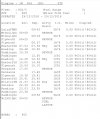https://www.networkrail.co.uk/running-the-railway/the-timetable/working-timetable/ has the current and previous Working Timetables. You can download the whole thing for one WTT period by clicking on that WTT on the linked page, scrolling down to the bottom of the list, and then downloading the file there. If that makes sense!
https://www.2d53.co.uk/graph/GRmenu.htm is almost always linked to when the discussion of timetable graphs comes up - and quite rightly too. It's a really good way of getting your head around how timetable graphs work, and allows you to manipulate what you can and can't see on each graph, thus allowing you to built up a better picture of what's going on.
I seem to remember making a thread asking a similar sort of question a while ago, but I can't find a link to it. These other links may be of some interest, though:
Hello all, Having seen Part Time Spotter's site (here) with the Class 717 diagrams on it, I was wondering - is there anything online which is similar to this for the units which work the Cotswold Line? (e.g. Class 800s, 802s, 165s, and 166s)? I don't know a lot about diagrams, but I do know...

www.railforums.co.uk
This one is more specific than this thread, as it's about the Cotswold Line, but there might be some information you could find useful (although I understand there's quite a bit in it).
https://partimespotter.wordpress.com/ is good for diagrams. If you hover over the "Diagrams" bit near the topic of the page, you'll see a drop-down list of diagrams available. They're not necessarily all 100% accurate all the time, but they're pretty good.
Essentially, from what I remember having asked a similar question on here before, a diagram is a collection of services on a particular day(s) which are to be worked by a form of train (either a loco-hauled set or a multiple unit).
I hope this is somewhat useful/understandable!
-Peter




